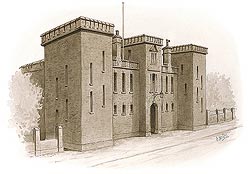The Regimental Depots
Kingston-Upon-Thames
 |
| The Barracks, Kingston-upon-Thames. |
The Barracks, Kingston-upon-Thames
The barracks were built on agricultural land, the fields of Park
Farm still being shown on three sides of it on a map of 1879.
Park Farm belonged to Lord Liverpool, the buildings cost £40,000.
There have always been soldiers stationed in Kingston. Situated at a Thames crossing and on the road between London and Portsmouth, it was always a busy place. Seven Anglo-Saxon Kings were crowned in the King’s town, and later its proximity to Hampton Court Palace probably added to its importance. In 1554 the protestant Sir Thomas Wyatt attempted to overthrow Queen Mary, but after burning the bridge his rebellion came to nothing. One hundred of his followers, including himself were executed in the town as traitors.
It is recorded that regular troops, including the 8th Foot (later the King’s Liverpool Regt) were stationed in Kingston in 1685. Most of his standing army was usually on standby at Hounslow Heath which is only a few miles away. Regulars in those days were billeted out on the civilian population, this was one of the reasons why the army at home was unpopular and later why it was more convenient to keep most troops abroad. The Militia and Volunteer Units, being locals, could usually live at home or be billeted near by, so barracks were not required until Victorian times. Early in the 19th century there was a Militia Barracks in the Fairfield.
In 1782 county titles were introduced for Regiments of Infantry, ostensibly to foster a connection with a particular county, but primarily to establish a base for the ever present problem of raising recruits. In April 1873, eight years before their final amalgamation, the 31st and 70th were linked together into 47 Sub-District Brigade. The Brigade Depot was established at Kingston and it was here that recruits for the two Regiments were trained. The barracks were designed by the Royal Engineers as a ‘Brigade Depot Centre’, and recruits for the 70th Foot, then in India were trained there. The barracks were built in 1874/75 and according to the Surrey Comet, ‘it was the last word in barracks building for its time’. Its designer was a Major Siddon RE.
Related
